Since the launch of Nvidia’s RTX 2000 series of cards, “ray-tracing” has been a buzzword in the PC gaming market. Now what exactly is ray tracing, how does it work, and why is it such a major breakthrough for the gaming industry? This guide will explain it all.
Key Takeaways
- Ray tracing is a graphics rendering technique that uses complex algorithms to trace the path of light in games and animations to make the lighting as realistic as possible. Light reflects, refracts, and forms shadows realistically, just like in real life.
- Compared to rasterization, ray tracing is a lot more intensive. At the same time, it generates much more realistic lighting and soft shadows that rasterization cannot.
- Path tracing is a much more computationally intensive form of ray tracing that provides better illumination and the ability to form accurate soft shadows.
What Is Ray Tracing?
Ray tracing is a rendering technique that creates realistic reflections, refractions, shadows, and indirect lighting to properly recreate the lighting of a scene and its objects. It is a graphics rendering method that uses AI to trace light rays to mimic the behaviour of light in real life. It applies the real-life physical properties of light to display realistic lighting in animation[1].

The Process
This process is carried out for each pixel, as a single ray of light is passed through each pixel. The simplest way to think of ray tracing practically is by looking at any object in your room illuminated by light. From that object, move your eyes toward the light source. That is exactly what happens in ray tracing[2].
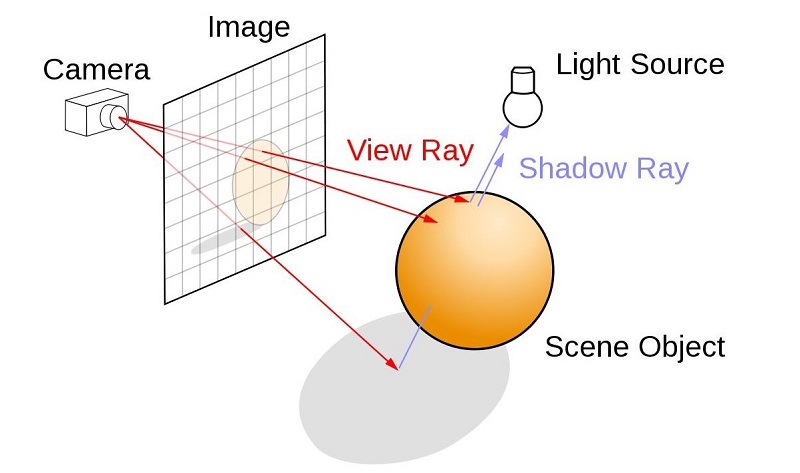
Ray Tracing In Games (Real-Time Ray Tracing)
Real-time ray tracing was only made possible in 2018 as Nvidia launched their Turing-powered RTX 2000 cards. These cards featured new Ray Tracing (RT) cores that are capable of performing real-time ray tracing[3]. AMD hopped on board in 2020 with their RX 6000 series GPUs, which featured dedicated RT accelerators[4].
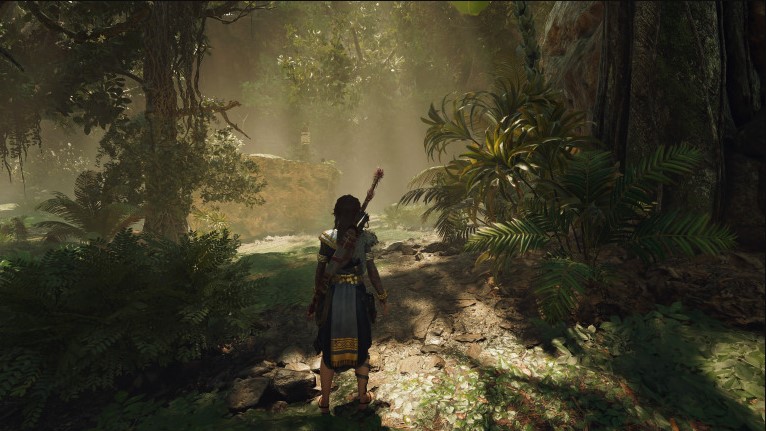
The type of ray-tracing (used in big-budget animated movies) is offline ray-tracing, which works on the same principle. Pixar’s Toy Story (1995) was the first movie to use the technology[5].
Ray Tracing Vs Rasterization
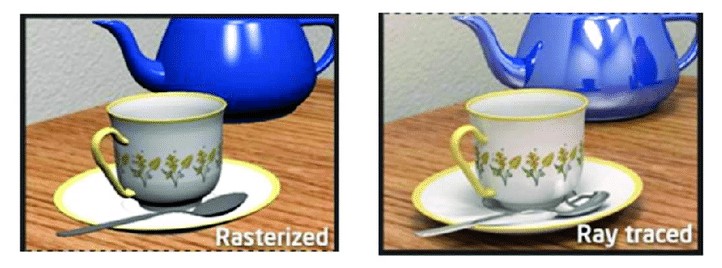
Here is an in-depth comparison of Ray Tracing vs. rasterisation.
| Ray Tracing | Rasterization |
|---|---|
| Ray tracing is a rendering technique used to simulate realistic lighting in video games and animation. | Rasterization is also a rendering technique. It converts a 3D mesh of polygons into 2D pixels on your screen. |
| Ray tracing is much more computationally intensive. | Rasterization is not as intensive and thus is also the widely used rendering technique in video games. |
| Ray tracing uses algorithms to accurately mimic the physical properties of light, such as reflections and refractions. | Rasterization “fakes” the behaviour of light and does not always generate accurate shadows and reflections. |
| Real-time ray tracing (used in video games) requires dedicated hardware. (RT cores or RT accelerators) | Rasterization does not require dedicated hardware. |
Ray Tracing Vs Path Tracing
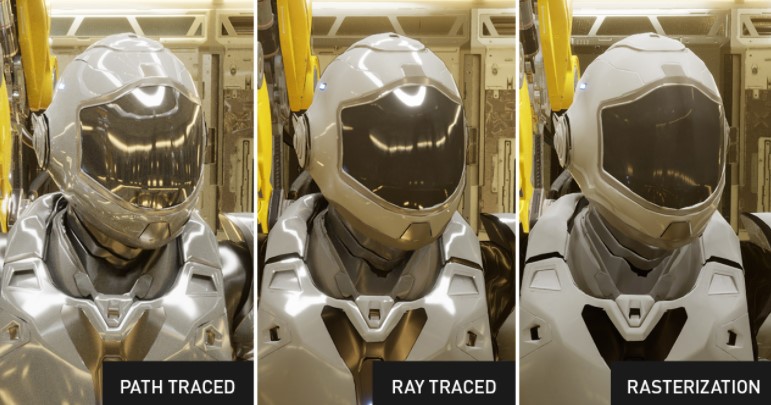
Mentioned below is a comparison between Ray Tracing and Path Tracing.
| Ray Tracing | Path Tracing |
|---|---|
| In ray tracing, only a single ray is passed through each pixel. | In path tracing, multiple rays are passed through a single pixel. |
| Ray tracing traces the path of every light ray that passes through a pixel. | Path tracing only traces the path of a certain few light rays. (those that follow the most accurate path) |
| Ray tracing does not calculate soft shadows accurately and is not as illuminating. | Path tracing is a lot more illuminating and calculates soft shadows accurately. |
| It is not as computationally intensive. | More computationally intensive than ray tracing. |
Final Words
Ray tracing is a technology for the future that can stimulate true-to-life lighting in video games and animations. It is, however, computationally expensive, and achieving a stable 60 FPS, especially on higher resolutions, is still only possible on fairly expensive GPUs. However, with hardware advancing more and more every year, ray tracing is becoming easier to run and more common too.
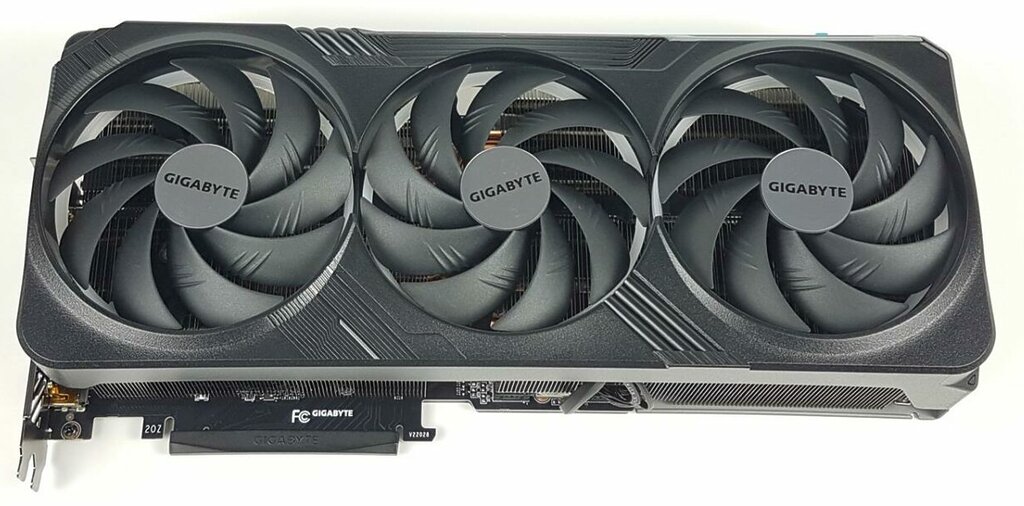
Related Helpful Resources By Tech4Gamers:
References:
- RAY TRACING. Retrieved from: https://developer.nvidia.com/discover/ray-tracing
- Adobe. How does Ray tracing work? Retrieved from: https://www.adobe.com/products/substance3d/discover/what-is-ray-tracing.html
- Nvidia. Geforce RTX 20 Series. Retrieved from: https://www.nvidia.com/en-us/geforce/20-series/
- AMD. Radeon RX 6000 Graphics cards. Retrieved from: https://www.amd.com/en/graphics/radeon-rx-graphics-6000-series
- Mark Henne. The Making of Toy Story. Retrieved from: https://people.uncw.edu/ricanekk/teaching/spring09/csc100/lectures/pattersone/TheMakingOfToyStory.pdf
Frequently Asked Questions
Ray tracing enables games to display realistic lighting, reflections, and refractions. It is certainly worth it, given you can afford the hardware to handle it.
First, ensure the game you’re playing has ray-tracing support. Once you’re sure it does, you need to proceed to the “advanced video settings” or “graphics settings” tab in-game look for “Ray Tracing” or “Ray Tracing Mode” and choose your desired setting.
Video games perform real-time ray tracing and require a GPU with RT cores (in the case of Nvidia) or RT accelerators (in the case of AMD). For other software-based ray tracing applications (like Lumen), such cores aren’t necessary.
Ray tracing sends a single ray through each pixel and traces the path of all the rays. Path tracing sends multiple rays through a pixel but only traces the path of certain rays. Furthermore, path tracing provides better illumination than ray tracing.
Thank you! Please share your positive feedback. 🔋
How could we improve this post? Please Help us. 😔
[Wiki Editor]
Ali Rashid Khan is an avid gamer, hardware enthusiast, photographer, and devoted litterateur with a period of experience spanning more than 14 years. Sporting a specialization with regards to the latest tech in flagship phones, gaming laptops, and top-of-the-line PCs, Ali is known for consistently presenting the most detailed objective perspective on all types of gaming products, ranging from the Best Motherboards, CPU Coolers, RAM kits, GPUs, and PSUs amongst numerous other peripherals. When he’s not busy writing, you’ll find Ali meddling with mechanical keyboards, indulging in vehicular racing, or professionally competing worldwide with fellow mind-sport athletes in Scrabble at an international level. Currently speaking, Ali has completed his A-Level GCEs with plans to go into either Allopathic Medicine or Business Studies, or who knows, perhaps a full-time dedicated technological journalist.
Get In Touch: alirashid@tech4gamers.com


 Threads
Threads
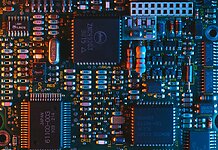
![Power Supply 80+ Certification [Explained] be quiet! Dark Power Pro 80 Plus Titanium Branding](https://tech4gamers.com/wp-content/uploads/2024/05/be-quiet-Dark-Power-Pro-80-Plus-Titanium-Branding-218x150.jpg)

![What Is NAND Flash Memory? [All To Know] CORSAIR MP600 2TB NVMe SSD - NAND Flash](https://tech4gamers.com/wp-content/uploads/2024/02/CORSAIR-MP600-2TB-NVMe-SSD-NAND-Flash-218x150.jpg)